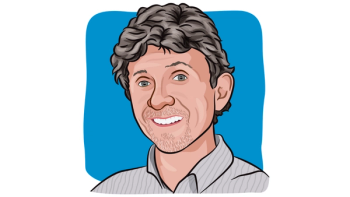After adapting to life with a multiple myeloma diagnosis in 2017, Todd Kennedy turned a challenging life chapter to a renewed sense of purpose, driving him and his wife into full-time advocacy for the cancer community.
Now in his first remission following quadruplet therapy with Darzalex Faspro (daratumumab and hyaluronidase-fihj), he experienced a complete shift from his initial intravenous (IV) treatment. The transition to subcutaneous (Sub-Q) administration empowered him to regain control of his schedule and overall productivity
"This allows you to put life first and treatment second," Kennedy said in an interview with CURE.
Darzalex Faspro is available for use in the following select patient populations with multiple myeloma:
- in combination with Velcade (bortezomib), melphalan and prednisone in newly diagnosed patients who are ineligible for autologous stem cell transplant (ASCT)
- in combination with Revlimid (lenalidomide) and dexamethasone in newly diagnosed patients who are ineligible for ASCT and in patients with relapsed or refractory multiple myeloma who have received at least one prior therapy
- in combination with Velcade and dexamethasone in patients who have received at least one prior therapy
- in combination with Velcade, Thalomid (thalidomide), and dexamethasone in newly diagnosed patients who are eligible for transplant
- in combination with Pomalyst (pomalidomide) and dexamethasone in patients who have received at least one prior line of therapy including Revlimid and a proteasome inhibitor (PI)
- in combination with Kyprolis (carfilzomib) and dexamethasone in patients with relapsed or refractory multiple myeloma who have received one to three prior lines of therapy
- as a single agent in patients who have received at least three prior lines of therapy, including a PI and an immunomodulatory agent or who are double-refractory to a PI and an immunomodulatory agent.
Most recently, the U.S. Food and Drug Administration (FDA) approved Darzalex Faspro for the treatment of adults with high-risk smoldering multiple myeloma in November 2025.
In the interview, Kennedy dove into his journey with multiple myeloma diagnosis and shared how the transition from IV to Sub-Q administration of treatment improved his quality of life.
CURE: Could you discuss your journey with multiple myeloma?
Kennedy: Life is really good, and frankly, it's been even better through cancer, not despite it, because of the incredible people I’ve met, the experiences I've had, and the availability of effective, tolerable treatment that allows me to have a great quality of life.
My cancer journey started completely out of the blue in December 2017. I was a healthy 52-year-old, likely in the best shape of my adult life. I had the back pain that so many of us get as we age. I had been going to my local orthopedic doctor for steroid shots that usually did the trick. When the pain flared up again in mid-2017, I went in, and he suggested an MRI before giving me another shot.
The day after Christmas, I returned for the results. My doctor was as shocked as I was. The report showed lesions up and down my spine and a tumor the size of his thumb on my hip. He said, "I'm sorry. You've got cancer."
That moment, I think every patient who hears those three words experiences, was an out-of-body feeling. Cancer had never been part of our family story, so we had no idea how to process the next steps, where to go for trustworthy information, or quality care.
Getting a diagnosis around Christmas is difficult because many doctors are out of the office. But this unexpected delay gave us time to do our homework. We kept hearing the same advice: "You have to get to an NCI-designated center." Myeloma is complex, and an expert can truly change the course of your care.
I ended up at an NCI-designated center, City of Hope. In February 2018, the leader of the myeloma program started me quickly on quadruplet therapy. This was not the standard of care at the time; it was what they were doing in clinical trials. She saw its promise. The key difference was the addition of Darzalex [daratumumab].
I had quadruplet therapy for induction, followed by my stem cell transplant. I've been on maintenance therapy ever since. In November 2018, we declared I was in remission. I'm still in my first remission, which I think speaks to the power of that initial quadruplet therapy combination.
In 2020, after working full-time in the pharmaceutical industry for 30 years—including through my first two years of intense induction therapy and transplant—I decided to retire. I felt a calling to leverage not only my professional experience but also my patient experience and focus on advocacy. My wife, who is a writer and marketer, joined me. We now work to accelerate research, improve the patient experience, and help more patients become educated and empowered for better outcomes. It’s been an incredible blessing and a renewed sense of purpose.
Let's discuss your experience with quadruplet therapy, specifically the differences between the IV and Sub-Q administration of Darzalex. How did that affect your quality of life?
Comparing the two periods makes the difference crystal clear. In the beginning, Darzalex dosing was weekly, then biweekly, then monthly. That meant I was in the infusion center all the time. The time burden was unbelievable.
My typical experience started at sunrise. The cancer center was an hour and a half away. We'd arrive, do labs, see the doctor, and then go up to the infusion center. After intake, pharmacy would prepare the weight-based IV medications.
Then came the pre-meds: They gave me Benadryl and dexamethasone by IV because the Darzalex was IV. They had to be started one hour before the Darzalex infusion.
The first dose of Darzalex was seven hours long. It's infused very slowly due to the significant risk of infusion-related reactions, such as fever, chills, shortness of breath. Seven hours is brutal, but even after that, it transitioned to a three-hour infusion for most of the first two years.
I was determined to keep working full-time. I'd sit there with the bag and pole, trying desperately to type on my laptop, battling the IV Benadryl trying to knock me out and the IV dexamethasone trying to hype me up. I’d often set off the IV line alarms trying to move my fingers [on the keyboard].
From sunrise to sunset, the day was gone. Because the Benadryl would knock me out, I couldn't drive home in Los Angeles traffic. My wife had to sacrifice her own productivity and take the day off to drive me. This had an indirect but huge impact on our costs and our family life—our high school son would come home to an empty house and needed friends to drive him to hockey practice. We had to arrange for people to come let our dog out.
When people say the switch from IV to Sub-Q is "just a convenience," I get upset. It is a huge deal. Patients shouldn't have to choose between treatment efficacy and quality of life.
Can you walk us through what your appointments looked like once you transitioned to subcutaneous Darzalex, and how that shift affected your lifestyle?
In 2020, Darzalex Faspro (the Sub-Q version) changed the game. The infusion time went from three hours (or an hour and a half at the very end) to three to five minutes.
It also changed the entire treatment mindset. Since Darzalex was no longer IV, they said, "Why give the dexamethasone or Benadryl IV?" Now, I take my oral Benadryl, dexamethasone, and Tylenol at home an hour before I arrive. I come in, do labs, see the doctor, and the pharmacy sends down the fixed-dose of Darzalex Faspro. They give me the shot, and in three minutes, I’m on the road.
City of Hope now has "Faspro Friday" because they can cycle so many patients through. Instead of being stuck in an infusion chair for four or five hours, the increased capacity means everyone is in and out much faster.
This shift allows you to put life first and treatment second. That's why real-world data show about 90% of patients strongly prefer Sub-Q administration over IV. It's not just convenience; it means less time away from work, less disruption for caregivers, and a significant improvement in overall quality of life.
References
- DARZALEX FASPROTM (daratumumab and hyaluronidase-fihj) prescribing information. FDA; Nov. 2025.
- “FDA approves daratumumab and hyaluronidase-fihj for high-risk smoldering multiple myeloma,” FDA; Nov. 6, 2025. https://www.fda.gov/drugs/resources-information-approved-drugs/fda-approves-daratumumab-and-hyaluronidase-fihj-high-risk-smoldering-multiple-myeloma







